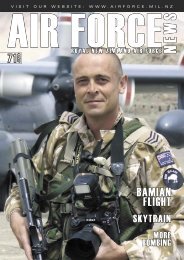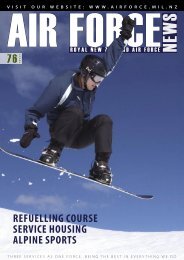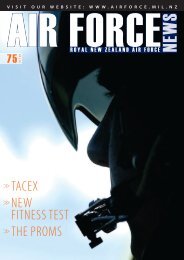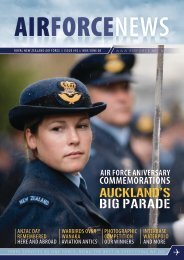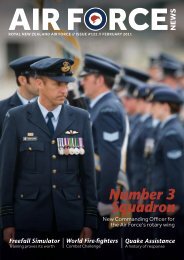February 2007, Issue 78 [pdf 3mb, 44 pages] - Royal New Zealand ...
February 2007, Issue 78 [pdf 3mb, 44 pages] - Royal New Zealand ...
February 2007, Issue 78 [pdf 3mb, 44 pages] - Royal New Zealand ...
You also want an ePaper? Increase the reach of your titles
YUMPU automatically turns print PDFs into web optimized ePapers that Google loves.
24<br />
HYPOBARIC CHAMBER REVIVED<br />
Most military Air Forces conduct hypoxia<br />
training for their aircrew. Hypoxia is a<br />
condition where there is lack of oxygen<br />
to critical tissues within the body, usually<br />
the brain and the retina. This causes a<br />
spectrum of symptoms that include vision<br />
and colour degradation, difficulty with<br />
problem solving and making decisions,<br />
difficulty with calculations, a ‘she’ll be right<br />
attitude’ and often memory loss. The main<br />
cause of hypoxia is inadvertent exposure<br />
to altitude, either due to a rapid loss of<br />
cabin pressurisation or a slow, subtle<br />
decompression that may go unnoticed<br />
by aircrew.<br />
Hypoxia is a killer and every couple of<br />
years there are lives lost due to high profile<br />
hypoxia incidents. A few years ago a<br />
civilian King Air crashed in Australia after<br />
running out of fuel because the aircrew<br />
had become incapacitated. More recently<br />
a Cypriot Boeing 737 crashed in Greece,<br />
the probable cause - HYPOXIA.<br />
The purpose of hypoxia training is to give<br />
aircrew an appreciation of the dangers of<br />
hypoxia and to allow them to experience<br />
the symptoms in a controlled environment,<br />
with the expectation that if they experience<br />
the symptoms in the operational setting,<br />
they will recognise the condition and<br />
take appropriate, and possibly life saving<br />
action.<br />
In 2002 the RNZAF ceased hypobaric<br />
chamber hypoxia training because the<br />
RAAF were reporting a high incidence<br />
of decompression illness during their<br />
hypoxia training (decompression illness<br />
is caused by nitrogen bubble formation in<br />
the tissues of the body and is an inevitable<br />
consequence of exposure to altitude over<br />
a period of time). Although the RNZAF<br />
had no reported incidents over the past<br />
18 years, our chamber was closed by the<br />
previous Director of Air Force Medicine<br />
to allow the Australian situation to be<br />
fully evaluated. The closure also allowed<br />
for our chamber operations, chamber<br />
maintenance and OSH practices to be<br />
re-assessed.<br />
The cause of the high incidence of<br />
decompression illness during RAAF<br />
hypobaric training was never fully<br />
explained. Early this year Director of<br />
Training, in conjunction with the Aviation<br />
AK 06-0576-15 ALL IMAGES AC RACHEL MAIN<br />
AK 06-0576-14<br />
Internal instructors under training - MAJ Sue Chambers-Ross, FLTLT Ben Johnston, CPL Clarie<br />
Beauvais, LAC Rachyl Harris, LAC Amanda Johnston - first sit for 30 minutes while the chamber gets<br />
to the right altitude.<br />
A bit of light reading on the way up. SQNLDR Bagnall checks the time.<br />
Medicine Unit, performed risk/benefit<br />
analysis of providing hypobaric hypoxia<br />
training for our aircrew and in a report to<br />
Chief of Air Force DTRG (F) recommended<br />
the re-commencement of chamber<br />
training. This was accepted by CAF in May<br />
2006 and over the past few months AMU<br />
and Auckland based engineers have been<br />
working towards re-commissioning of the<br />
chamber. The chamber went through a<br />
rigorous Air Worthiness programme and<br />
on 2 November 2006 the Airworthiness<br />
and Capability Management Board<br />
recommended that the chamber be recertified.<br />
On 11 December 2006 the first live run<br />
in over 4 years was conducted as the final<br />
‘check flight’ for the newly trained internal<br />
instructors.<br />
The ground training of new internal<br />
AFN<strong>78</strong> FEBRUARY 07<br />
www.airforce.mil.nz<br />
AK 06-0576-13<br />
instructors and the chamber run went as<br />
planned, and on 15 December 2006 the<br />
first hypoxia training run was conducted<br />
for aircrew.<br />
The plan is to run a regular weekly onehour<br />
lecture/chamber brief followed by<br />
a hypoxia run.<br />
This ‘catch-up’ course will be in addition<br />
to the regular Aviation Medicine Refresher<br />
courses conducted by AMU.<br />
AFN<strong>78</strong> FEBRUARY 07 www.airforce.mil.nz<br />
SQNLDR Len Bagnall, OC AMU<br />
says ‘it has been a lot of hard work recommissioning<br />
the chamber, but the end<br />
result is very satisfying. Hypoxia is an<br />
ever-present danger, and if over the years<br />
we can save even one life, the time and<br />
effort will have been worthwhile. It was<br />
great to re-new my 18 year partnership<br />
with Mr Bruce Neagle who has operated<br />
and maintained the chamber for over<br />
AK 06-0576-22 AK 06-0576-20 AK 06-0576-16<br />
SQNLDR Bagnall and Mr Bruce Neagle just prior<br />
to the first live run in over 4 years.<br />
Participant’s reactions are checked at 25,000 feet.<br />
22 years. Bruce came out of retirement<br />
to ensure that we got ‘his baby’ up and<br />
running.’<br />
‘We were all a bit apprehensive prior to<br />
the first live run in over 4 years, but with<br />
the controller’s familiar words “Bruce,<br />
ascend the chamber to 18 thousand feet<br />
at 6 thousand feet per minute”, we knew<br />
we were back in the groove and back in<br />
business,’ he said.<br />
25


![February 2007, Issue 78 [pdf 3mb, 44 pages] - Royal New Zealand ...](https://img.yumpu.com/17485296/24/500x640/february-2007-issue-78-pdf-3mb-44-pages-royal-new-zealand-.jpg)
